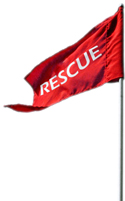Loss of Bladder Control

Urinary incontinence is the loss of ability to hold in urine.
What Are the Causes of Urinary Incontinence?
Below are some common reasons why stroke survivors may have trouble controlling their bladder:
- Injury to the part of the brain that controls the urge to pass urine
- Memory problems and forgetting to urinate
- Trouble getting to the bathroom. It may be hard for survivors to walk to the toilet. They may also have a problem talking to people and asking for help.
- Illnesses like bladder infections
- Side effects of some medicines
What Do You Need to Know?
Almost all stroke survivors will have some degree of incontinence. Some survivors have accidents once in a while. Others cannot hold their urine at all. The good news is that incontinence can be managed, treated and sometimes cured.
Why Is It Important to Get Help?
Some problems with controlling loss of urine are due to illnesses or other easily treated problems. It is important that your loved one be looked at by a healthcare provider. Your healthcare team can work with you and your loved one to help manage the problem.
What Treatments Should You Discuss with Your Healthcare Team? 
Regular or fixed toilet times – Visiting the toilet at fixed times may help to retrain the bladder and prevent accidents.
Bladder retraining with urge suppression – This may help survivors get control over the times they use the toilet. First, establish fixed toilet times. Slowly increase the time between trips to the toilet. Teach survivors to wait at least ten minutes after they feel the need to urinate. Suggest ways to relax and postpone the urge to urinate. For example, have them think about pleasant events.
Exercises – There are exercises that can make the muscles that hold the bladder stronger. These exercises are called pelvic floor muscle exercises (Kegel exercises). The Mayo Clinic has more information about Kegel exercises on their Web site. Go to the Resources section for a link.
A urinary foley catheter – This is a small tube that is sometimes used to pass urine soon after a stroke. The catheter is removed when the survivor no longer needs it. Foley catheters are used only when necessary. MedlinePlus has more information about how to care for catheters. The Resources has a link to their Web site.
A condom catheter – This is a pouch-like device that is placed around a man’s penis and then connects to a tube. The tube empties urine into a storage bag. MedlinePlus has information on how to care for condom catheters. The Resources section at the end of this fact sheet has a link to their Web site.
Other devices and medicines – For women, medical devices that support the bladder, such as pessaries, are sometimes used. Some medicines can prevent accidents and calm the bladder.
Helpful Tips
Talk about the problem:
- First, talk with your healthcare team. Stroke survivors are often embarrassed and have trouble talking about incontinence. Directly discuss their concerns.
- Use sensitivity and tact. Remember that accidents happen and are not your loved one’s fault.
Ways to manage bladder control problems:
- Allow your loved one privacy and plenty of time to sit on the toilet.
- Make sure the survivor drinks four to six glasses of water during the day. Avoid fluids two to three hours before bedtime.
- Help the patient limit foods and beverages that irritate the bladder. Limit caffeine (such as coffee, tea, cola), artificial sweeteners, alcohol, chocolate, acidic foods (such as tomatoes, oranges) and very spicy foods.
Consider the purchase of products and equipment:
- A bedside commode or a urinal near the bed is often helpful. Put the commode and urinal in the closet during the day to avoid embarrassing your loved one.
- A raised toilet seat or grab bars in the bathroom may prevent falling.
- Disposable or washable bed pads are available in drug stores or medical supply houses. Place these pads underneath the sheets so they are less noticeable.
- On long trips, disposable undergarments may be used for protection. Designs to choose from include diapers, pads, underwear liners and undergarments that are worn just like regular underwear. Use these undergarments only when necessary. Your loved one may rely on them and avoid trying other options.
If your loved one has memory or communication problems:
- Watch for signs that your loved one needs to use the toilet. Common signs are changes in facial expressions, restlessness or aimless pulling at clothes.
- Help your loved one to the bathroom every two to three hours.
- Encourage and praise your loved one after toilet use.
If an accident occurs, try the following to remove stains:
- Mix together: one cup of hot (not boiling) tap water, one tablespoon of powdered laundry detergent, and one tablespoon of white vinegar.
- With a sponge, apply to the stained area until very wet.
- Place folded towels over the area to absorb the fluid.
- Leave towels in place overnight.
|
Red Flag: Changes in Urination 
Call your healthcare provider right away if any of these changes occur: |
Remember
- The first step is to discuss incontinence problems with your healthcare team.
- Be sensitive and remember that accidents are not the fault of your loved one.
- The good news is that incontinence can be managed, treated and often cured.
Other Resources 
Additional credible resources on this topic can be found here. Website pages may change or update, therefore if a link does not work, you may also try to type the information into your internet search bar. This Resource List will be updated frequently.
References: National Stroke Association. (2006). Stroke Facts; Recovery after Stroke: Bladder & Bowel Function. Retrieved June 30, 2008, from http://www.stroke.org/site/DocServer/NSAFactSheet_BowelandBladder.pdf?docID=984*; How to Care. (2000). Your Eldercare Survival Guide. Retrieved June 30, 2008, from http://www.howtocare.com*; Dreslin, J. (n.d.). Stroke Awareness for Everyone; Stroke Caregivers Handbook. Retrieved on June 30, 2008, from http://www.strokesafe.org/Handbook.html*.
These materials were created for the project:
Web-Based Informational Materials for Caregivers of Veterans Post-Stroke
Project Number SDP 06-327 funded by VA HSR&D Quality Enhancement Research Initiative (QUERI)



















